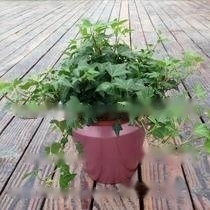
Chinese name: Ivy
Latin name: Hedera nepalensis K, Koch var.sin ensis (Tobl.) Rehd
Aliases: earth drum vine, Drilling wind, triangle wind, scattered bone wind, maple lotus pear vine. Ivy
Effects: Dispel wind-dampness, promote blood circulation and reduce swelling
Distribution area: Produced in Shaanxi, Gansu and the south of the Yellow River Basin to South and Southwest China
1 , Ivy form
Ivy is a perennial evergreen climbing shrub with a length of three to twenty centimeters, and its stem veins are gray-brown or black-brown, relatively smooth. The paper strips when young have scale-like pilose on them, and the scales have ten to twenty radiating ribs. The leaves are simple and alternate, petioles two to nine centimeters in length, and scales. The inflorescences are umbel-shaped, single terminal, or two to seven in a racemose arrangement, with a diameter of 1.5 cm to 2.5 cm, and flowers ranging from five to forty. The calyx is scaly, 2 mm long. The petals have five petals, are triangular-oval, about 3 mm to 3.5 mm in length, and are pale green or yellowish white.
2. Habits of ivy
Ivy is a negative vine that can also grow in a full-light environment. It grows well in warm and humid climates and is not cold-resistant. Lax on soil requirements, like moist, loose, fertile soil, not salt-alkali. It often climbs on trees at the edge of the forest, on the roadside under the forest, on rocks and on the walls of houses, and is often cultivated in gardens. It has a wide distribution area, from southeastern Gansu, southern Shaanxi, Henan, Shandong in the north, Guangdong (except Hainan Island), Jiangxi, Fujian in the south, Bomi, Tibet in the west, and Jiangsu and Zhejiang in the east. There are also distributions in Vietnam.
3. Cultivation of ivy
The best choice for ivy budding is in late spring and early summer, when sandy soil, garden soil and humus soil are mixed together as the cultivation soil. , After planting, pour water once permeable, put it in a cool place, and carry out normal management after the new branches grow. Change the pot once or twice a year. Before planting, put decomposed organic fertilizer on the bottom of the pot as base fertilizer, and cut off the root system that is too long and dense. The optimum temperature for growth is 18-20°C. When the temperature exceeds 35°C, the leaves turn yellow and the growth stops. Therefore, it should be shaded when it is hot in summer, or placed in a sparsely sprouted place to avoid direct sunlight.
Guess you like it
Fortune Tree | Green Radish | Lucky Bamboo | Aloe Vera | Asparagus | Milan | Wang Lian | Evergreen | Dripping Guanyin | Ivy |
Tieshu | Bougainvillea | Rubber tree | Douban green | Boxwood | Streak fern | Heather | One-leaf orchid | Monstera | Duck's Foot Wood | Kale | Nantian Bamboo | Sansevieria | Water Hyacinth | Water Bamboo | Guangdong Evergreen | Wine Bottle Orchid | Pittosporum | |Peony|Platycodon|Datura|Violet|Anthurium|Camellia|Daffodil|Cyclonia|
![[Dog Training 5] The training method of pet dog dining etiquette](/static/img/12192/12192_1.jpg)




